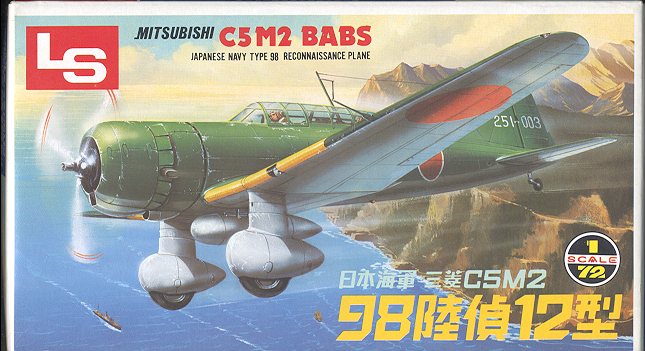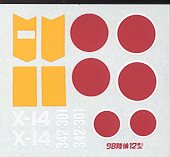
|
KIT: |
LS 1/72 C5M2 'Babs' |
|
KIT # |
A 206 |
|
PRICE: |
$3.50 (in 1984) |
|
DECALS: |
Two Aircraft |
|
REVIEW & |
|
|
NOTES: |

|
HISTORY |
One of the areas that the Japanese generally excelled in the years prior to and during WWII is with reconnaissance aircraft. The ability to build light weight airframes combined with fuel efficient engines is a perfect match for getting great range out of an aircraft. Even the A6M2 Zero was able to have a normal range of nearly 1,200 miles; an extraordinary feat for a single-engined fighter, even today.
Probably the best known recce bird of pre-war Japan was the Mitsubishi Ki-15. A civilianized version of the Ki-15-I entitled Karigane I and registered as the Kamikaze (Divine Wind) set a long distance record between Tachikawa to London in 1937. The aircraft flew 9,542 miles in 94 hours, averaging a bit over 100 mph and establishing a record for that distance.
With such range, the Army had an excellent recce aircraft. The Navy, however, did not have any long range aircraft of this type and relied on A5M Claude fighters for reconnaissance, a not very good option. Because of the war with China, such an aircraft was needed. so the Navy placed an order for 20 aircraft similar to the later Ki-15-II, but with Navy 875 hp Mistubishi Zuisei 12 engines. These aircraft were the C5M1.
A later development, the C5M2 had a more powerful 950 hp Nakajima Sakae 12 engine (the same as in the A6M2 Zero) and was built entirely to navy standards. Despite the increase in power, the additional weight of equipment meant that this version was a bit slower than the older aircraft. However, the aircraft performed its mission well and was extremely reliable. The aircraft equipped two Sentais, the 22nd and 23rd. It was a C5M2 from the 22nd that discovered the Prince of Wales and Repulse, a discovery that resulted in their sinking. Once it became obvious that they were no longer fast enough to escape enemy fighters, the C5M2 was withdrawn to Japan for use as advanced trainers and communications aircraft. A few were expended in kamikaze operations at the end of the war.
|
THE KIT |

Looking at this kit, it is difficult to believe that the mold is now over 30 years old. Despite a slightly 'pebbly' finish to the plastic, the engraved panel lines are sharp and crisp and the clear parts are well formed and thin. I am unsure if this kit derived from the Mania molds as did the Hasegawa Ki-15 kits. The artwork on the side of the box touts three other versions of this plane; the Ki-15-I, the civil Karigane I, and a C5M1. The big difference being the engine, which is on a separate sprue from the rest of the kit. There are some signs of age, like the adequate, but sparse cockpit as well as a few sinkmarks in thicker parts like the seats, pilots and wheel pants. However the rest of the kit is flash free and looks like a nice build.
 Instructions are
almost entirely in Japanese and are of a pictorial type in 10 steps. They are
easy enough to understand so construction should be no problem. There is also a
single exploded view showing all the pieces, an interesting touch, as well as a
diagram of the various trees. No color information is given at all, so one needs
to rely on the box art for that. The decal sheet is quite simple, offering basic
insignia, the yellow wing leading edges and two tail codes. The sheet looks
quite useable, even after over 15 years. I have no idea what units these are
for, though I suspect neither are the 22nd or 23rd Sentai. Both aircraft seem to
be in green over grey so painting will not be much of a challenge.
Instructions are
almost entirely in Japanese and are of a pictorial type in 10 steps. They are
easy enough to understand so construction should be no problem. There is also a
single exploded view showing all the pieces, an interesting touch, as well as a
diagram of the various trees. No color information is given at all, so one needs
to rely on the box art for that. The decal sheet is quite simple, offering basic
insignia, the yellow wing leading edges and two tail codes. The sheet looks
quite useable, even after over 15 years. I have no idea what units these are
for, though I suspect neither are the 22nd or 23rd Sentai. Both aircraft seem to
be in green over grey so painting will not be much of a challenge.
Bad news is that LS has been belly up for many years. Good news is that Arii has all the LS molds so this kit is probably going to be reissued some time in the near future if it is not already available.
|
REFERENCES |
Japanese Aircraft of the Pacific War by Rene J Francillon
Review kit courtesy of me and my wallet!
If you would like your product reviewed fairly and quickly by a site that averages over 2,400 visits a day, please contact me or see other details in the Note to Contributors.